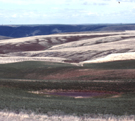An Urgent Signal for the Coming Ice Age
Harris, Peter John Faraday. 2008. An Urgent Signal for the Coming Ice Age
Full text [here]
Selected excerpts:
When paleoclimatologists met in 1972 to discuss how and when the present warm climate would end , termination of this warm climate we call the Holocene seemed imminent and it was expected that rapid cooling would lead to the coming ice age. These ideas were based on the 1M year analogue for climate transitions first proposed by Milankovitch over 60 years ago, which has been demonstrated to show the correlation of glacial and interglacial climate with solar insolation as it is modulated by our changing distance from the sun. These data sets may be used to serve as a signal for the coming ice age. Orbital geometry was approaching similar conditions to those of the previous transitions to ice.
But soon it was observed that global temperature was increasing and at about this time Global Climate Modeling (GCM) received more attention and the Milankovitch analogue was forgotten. There has been no further discussion about the coming ice age. …
Then using a modeled Holocene they projected climate using a range of CO2 forcing, and they reported that there was no transition to ice for at least 30KY into the future.
The algorithm for this process is not disclosed but the authors rightly list the limitations of the model in which CO2 is considered as an external forcing ie the carbon cycle is not simulated by the model. Clouds and the hydrological cycle are simplified and so is the heat transport to middle and deep ocean. In addition, regional changes such as the North Atlantic and over Europe are not simulated “and might depart from the global trend.”
It is unfortunate that these limitations appear to have been ignored and the AGW [anthropogenic global warming] hypothesis was born and has occupied science and the media ever since. The Milankovich analogue has been forgotten.
But the reality is that CO2 is not driving temperature up , in fact the data below suggests that global T may be cooling since 1998 and CO2 continues to climb. …
There is further detailed material here in a paper by Dr Willie Soon which shows that there is no evidence to support global warming by CO2. …
The climate trends during the Holocene, and also the regular sudden climate transitions between the ice ages and the interglacial climate over the past 1M years are better explained by reference to the great external driver, the Sun.
There is abundant archeological evidence to show that global T [temperature] is closely correlated with solar activity. …
The evidence for the solar insolation signal for the ice ages is contained in the Milankovitch analogue which has been overlooked for over 30 years. …
In studying the analogue there is no use of a GCM [global climate model] which is subject to limitations and interpretation. Use of the analogue is based on simple observation of clear empirical data and the archeological record of temperature. The data and the correlation are sound. …
This proposal offers the further advantage that it would provide a faster response which helps to explain the rapid climate change observed in the transitions. It is significant to note that at this tipping point, energy transport to the NH [Northern Hemisphere] is at a peak and there is abundant humidity transported to the NH at a critical time when insolation is in rapid decline.
These are the conditions which favour maximum precipitation in the NH winter. These are the conditions NOW. …
The geological record shows that the transitions are sudden, long term and extreme. All of the Milankovitch parameters for a transition are satisfied by the present orbital position. We have already seen extreme NH winter conditions and T appears to be declining in the short term. The decline will continue under rapidly declining insolation and the coincident effect of reduced solar activity which has also been correlated with temperature in the past.
It is possible that we may have already entered the sudden stage of the transition.
It is overdue time for engineers and scientists to reconsider the Milankovitch analogue and to plan for the contingency of an imminent transition to ice. I think that the AGW hypothesis has proven to be a costly diversion of resources.
